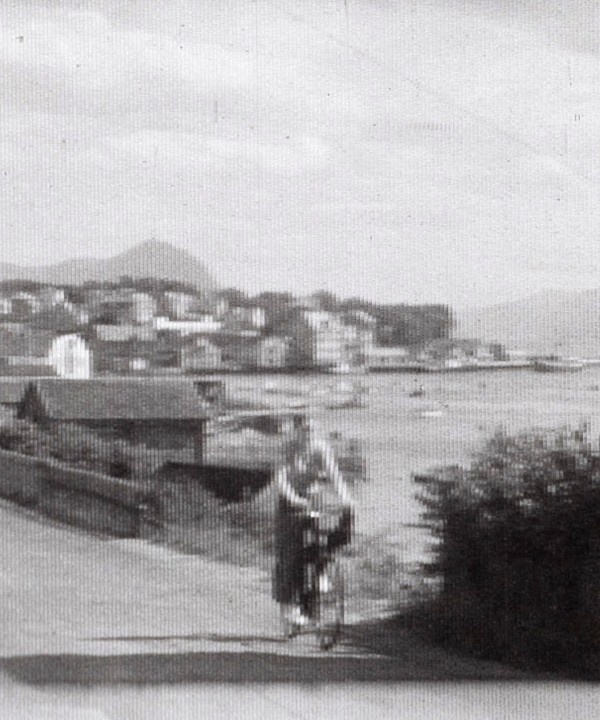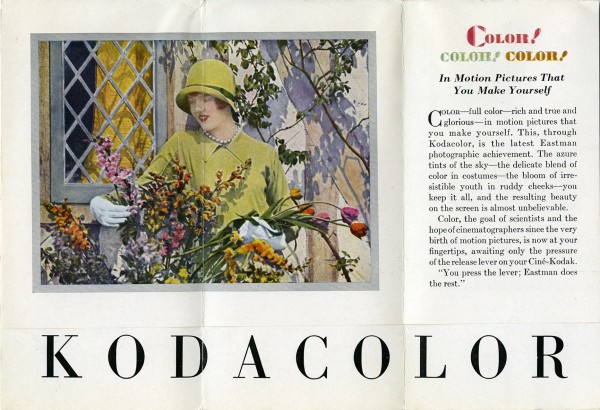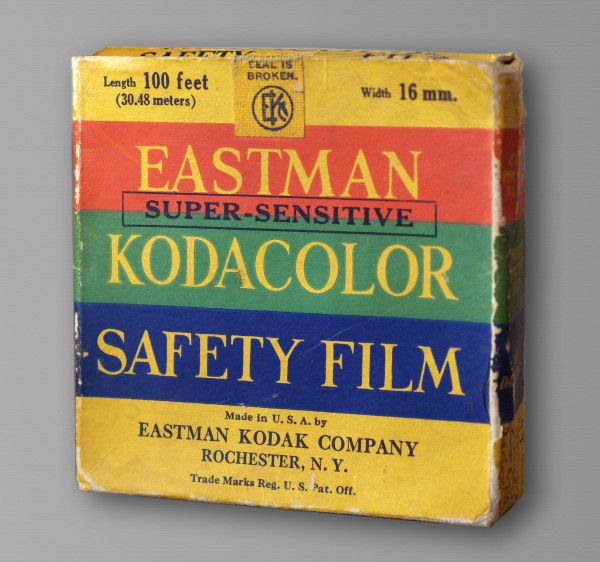An additive three-color lenticular screen process for 16mm amateur filmmakers.
Film Explorer

Unidentified film (c. 1930). The Kodacolor process photographed color information onto a panchromatic B/W reversal emulsion by shooting through a three-banded color filter on the camera lens and a special film stock that contained thin vertical lines of microlenses (called lenticules), embossed onto the film’s base. The color in the image was subsequently revealed on-screen during projection using the same three-banded color filter.
Film Technology Frames Collection, George Eastman Museum, Rochester, NY, United States.

Unidentified film (c. 1930). Kodacolor films are often noted as such long the film’s edge. Additionally, the base-side of the film displays a noticeable sheen when handled under reflected light.
Film Frame Collection, Seaver Center for Western History Research, Natural History Museum of Los Angeles County, Los Angeles, CA, United States.

Unidentified film (c. 1928). The earliest Kodacolor films do not display “KODACOLOR” on the film’s edge. Instead standard 16mm Eastman Kodak edge markings are present.
Identification
1
During projection, a color cast may be noticeable on both sides of the image due to the ghost image of the filter. Additionally, the lenticular array (a grid of vertical lines) is highly visible across the image.
None
10.26mm × 7.49mm (0.404 in × 0.295 in).
B/W panchromatic super-sensitive reversal emulsion. The base side of the film was embossed with lenticules.
Early Kodacolor films feature normal 16mm edge markings: KODAK SAFETY FILM. Later Kodacolor films are clearly marked KODACOLOR.
History
[This entry is a continuation of Keller-Dorian]
Kodacolor was an additive three-color process for amateur filmmakers that used 16mm panchromatic B/W reversal film. The film base was used as support for an optical system made up of semi-cylindrical microlenses engraved onto the base of the film. When shooting, an RGB (red/green/blue) three-banded filter was placed in front of the camera lens: each lenticular microlens on the B/W film reproduced a reduced real image of the RGB filter, which created three different color records behind each microlens.
As early as 1914, George Eastman had been informed of Pathé’s research into the lenticular process and wrote to Léon Gaumont: “[Charles Pathé] is about to bring out a color process which will revolutionize the Industry.” However, Pathé’s research, which had been overseen by Rodolphe Berthon, was interrupted by the commencement of World War I. It was not until 1924 that the Keller Dorian Film Company was incorporated, to pursue research into the lenticular film process and, eventually, to patent methods for embossing film stocks. Although Keller-Dorian was still at the experimental phase, engineers from Rochester were sent to Paris to evaluate the process – Eastman Kodak acquired the 16mm rights to the Berthon-Keller-Dorian patents in 1925.
In March 1926, during a trip to Paris, en route to a safari in Africa, Kodak founder George Eastman met with the directors of Keller-Dorian and attended a demonstration at company headquarters. A few weeks later, as he approached Port Sudan, in the Red Sea, Eastman wrote a long letter to his vice-president Frank Lovejoy:
“Last night I had a dream. I dreamed that Mees [the director of the research laboratory] came to Paris to examine the Keller-Dorian process and found no fundamental defects in it and that it was ready to be put into production.” (Eastman, 1926)
George Eastman had foreseen the considerable success that could be achieved by marketing film in “natural color” for the home-movie market and did not seem to doubt that his research team could quickly achieve a scaled-up version of the process, since as early as 1926, he was confident enough to announce the product to the press: “The film in natural colors within the reach of amateur filmmakers.” (Eastman, 1926)
John Capstaff, a research engineer in Rochester, was assigned to develop the Kodacolor process. He was known for his research work on Two-Color Kodachrome and the 16mm format. It took only three years for the Rochester research team under Capstaff to develop the process up to an industrial scale. This research represented a significant financial investment for the Rochester firm.
Kodacolor had a spectacular launch on July 30, 1928, at George Eastman’s mansion in Rochester. Many personalities were invited, including Thomas Edison. At the occasion, 16mm Kodak Model B cine-cameras were lent to the guests so that they could shoot footage of the garden party. That same evening, the films were then screened to the guests in color, arousing their enthusiasm.
The Kodacolor process is the only example of the Keller-Dorian-Berthon lenticular process being exploited at an industrial scale for the amateur film market. (In Germany, Agfa did offer its own 16mm lenticular process called Agfacolor Schmalfilm but it appears not to have been widely taken up). Kodacolor was well suited to amateur filmmakers, who could project the original film, with no need for prints to be made.
The only drawback of the process was pointed out by George Eastman as early as 1926 in a letter to Frank Lovejoy: “At present there is no method known by which the picture can be copied or duplicated, each picture must be original, this restricts it to the amateur use at present.” (Eastman, 1926)
In the early 1930s, research was carried out at Eastman Kodak's research laboratory to overcome this difficulty in an attempt to adapt the process for film industry use – mainly with Paramount and, after 1945, with 20th Century-Fox. But these attempts failed due to the insurmountable difficulty of obtaining copy prints of sufficient quality for theatrical release.
In 1935, the subtractive Kodachrome reversal process by Leopold Mannes and Leopold Godowsky Jr. was introduced by Eastman Kodak. This technological breakthrough led to the rapid decline of additive color processes such as Kodacolor.
Selected Filmography
A home movie featuring future US president Herbert Hoover, shot in January 1929. Preserved by the National Archives and Records Administration. https://catalog.archives.gov/id/55248772
A home movie featuring future US president Herbert Hoover, shot in January 1929. Preserved by the National Archives and Records Administration. https://catalog.archives.gov/id/55248772
One of the first Kodacolor films, made from footage shot at the Kodacolor launch party at George Eastman’s mansion in Rochester, NY. Preserved by George Eastman Museum using analog duplication.
One of the first Kodacolor films, made from footage shot at the Kodacolor launch party at George Eastman’s mansion in Rochester, NY. Preserved by George Eastman Museum using analog duplication.
Family footage photographed in Hollywood. Preserved by the Deutsche Kinemathek.
Family footage photographed in Hollywood. Preserved by the Deutsche Kinemathek.
Amateur footage documenting Parisian cultural life and personalities. Preserved by Forum des images. https://collections.forumdesimages.fr/CogniTellUI/faces/details.xhtml?id=VDP38389
Amateur footage documenting Parisian cultural life and personalities. Preserved by Forum des images. https://collections.forumdesimages.fr/CogniTellUI/faces/details.xhtml?id=VDP38389
Technology
The Kodacolor offered a turnkey system to the amateur filmmaker. Only 16mm Cine-Kodak cameras, models B, BB and K could be used. The process only worked with a 25mm anastigmatic lens (without optical aberrations), used at full aperture of f/1.9 with the three-banded RGB filter and a ‘ratio cap’ (to compensate for the variations of sensitivity of the various emulsions by reducing the height of the filter bands). Neutral-density filters were also provided to adjust the exposure in bright light conditions.
The 16mm embossed panchromatic reversal emulsion was sold in rolls of 50 ft and 100 ft (15.24m & 30.48m). The exposed film was developed in Kodak’s labs all over the world (except the USSR) and mailed back to customers ready to project. As the first-generation film stock was very slow due to the large amount of light absorbed by the trichrome filter, a new, “hypersensitive” film was introduced in 1932.
The projection was done according to the principle of reverse path of light, with 16mm Kodascope type A or B projectors. The trichromatic filter was fitted on the front of the projection lens, while a plano-convex lens was mounted on the rear-end barrel of the lens, in order to compensate for the difference between the 2-in (50.8mm) focal length of the projector and the 1-in (25.4mm) focal length of the camera lens.
Due to the large amount of light absorbed by the filter, and poor definition caused by the lenticular embossing, only small screens (typically 22 in x 30 in [0.59m x 0.76m) could be used, like the “Kodascope screen” – a highly-reflective aluminum screen.
Several difficulties had to be overcome before achieving a result that could be used on an industrial scale. The embossing process was the keystone of the process and was quite tricky. The engraving of the microlenses on the film base was the most delicate step – it was done in an embossing machine at a temperature close to 100 °C. This operation was carried out by pressing the film between two cylinders: an engraving cylinder, followed by a smooth counter roller. The temperature of the engraving cylinder had to be strictly maintained – a variation of a few degrees could modify the radius of curvature of the microlenses and affect the correct rendition of colors.
The engraving pitch was 22 lines to a millimeter (about 560 lines to an inch), which was within state-of-the-art engineering limits at the time, but a higher engraving pitch would have been pointless, given the low resolution of the optical system.

The Kodacolor lens unit, with the three-banded filter and compensating lens for projection.
Courtesy of François Ede.

An enlarged area of the film frame. The embossed lenticules on the film base appear as vertical lines across the image. As such, the perceived resolution of this process was considered quite poor and only small projection sizes were recommended.
Courtesy of Torbjørn Pedersen.
References
Brayer, Elizabeth. Georges Eastman a biography. University of Rochester Press, 2006. Pp.222-223.
Capstaff J. G. & M. W. Seymour (1928). “The Kodacolor process for amateur color cinematography”. Transactions of the SMPE, XII: 36 (Sept.): pp. 940–7.
Clark, Walter (1929). “Amateur Kinematography in colour: The Kodacolor process”. The Photographic Journal, 69 (Sep.): pp. 402–8.
Cornwell-Clyne, Adrian (1951). Colour Cinematography. London: Chapman & Hall, pp. 317–24
Eastman, George (1926). Correspondence with Frank Lovejoy (April 18). George Eastman Museum, Rochester, New York, United States. https://rbscp.lib.rochester.edu/sites/default/files/atoms/files/Box2_3.pdf
Eastman-Kodak Company (1928). Eastman Super-sensitive Kodacolor Safety Film. Rochester, NY: Eastman-Kodak Company.
Pfluger, David, Lutz Garmsen & Giorgio Trumpy (2022). “Modern methods for the visualization of lenticular film colors”. Color Culture and Science Journal , 14:1: pp. 64–72. https://jcolore.gruppodelcolore.it/ojs/index.php/CCSJ/article/view/266/229
Ryan, Roderick (1977). A History of Motion Picture Color Technology. Waltham, MA: Focal Press.
Patents
Capstaff, John G. Color photography. U.S. Patent 1,817,963, filed June 4, 1928, and issued August 11, 1931. https://patents.google.com/patent/US1817963A/
Preceded by
Followed by
Compare
Related entries
Author
François Ede is a cinematographer and a documentary filmmaker. He has restored several films shot with the Keller-Dorian process, including Jour de fête in 1994 and recently carried out the reconstruction and restoration of Abel Gance's La Roue (1923) for the Jérôme Seydoux-Pathé Foundation.
Torbjørn Pedersen
Ede, François (2025). “Kodacolor”. In James Layton (ed.), Film Atlas. www.filmatlas.com. Brussels: International Federation of Film Archives / Rochester, NY: George Eastman Museum.




